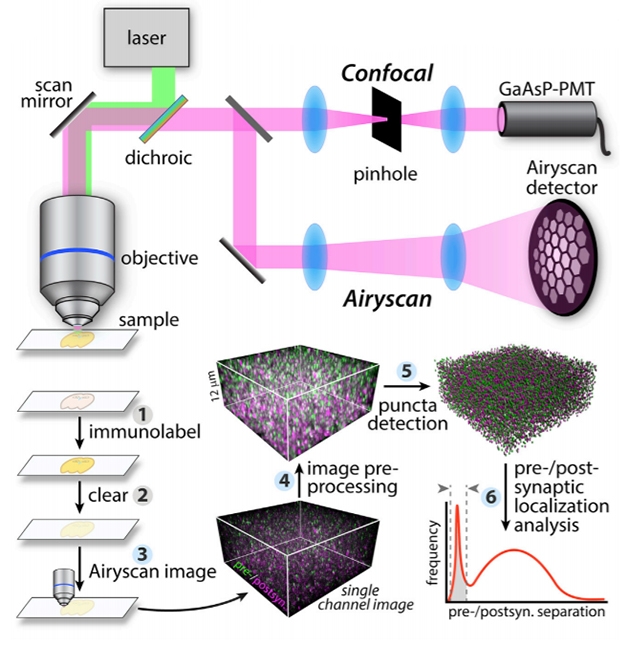Shiny SEQUIN: New Technique Counts Synapses Over Large Brain Volumes
Quick Links
Synapses are central in Alzheimer’s disease, but they are hard to study. The microscopic techniques that offer a glimpse at these tiny structures require expensive equipment and laborious ultra-sectioning of brain tissue, and cover only very small areas. Quicker techniques are typically low-resolution and cannot identify or count individual structures. Recently in Neuron, researchers led by Terrance Kummer at Washington University in St. Louis introduced a new method, called Synaptic Evaluation and Quantification by Imaging Nanostructure. Thank goodness for its acronym, SEQUIN.
SEQUIN combines ease of use with the ability to visualize and count individual functional synapses across large brain areas with the aid of automated software. “We wanted something researchers could pick up off the shelf and use,” Kummer told Alzforum. His lab has posted sample datasets and code to help other groups adapt the technique for their own applications.

SEQUIN Workflow. After tissue processing, an Airyscan microscope images and quantifies functional synapses within the sample. [Courtesy of Sauerbeck et al., Neuron.]
To develop SEQUIN, the researchers utilized image scanning microscopy (ISM), a sophisticated form of confocal microscopy (for review see Gregor and Enderlein, 2019). They used an Airyscan ISM microscope, which views tissue with high resolution but offers the same simplicity as typical confocal microscopes. However, this microscope visualizes but a few microns deep into a sample before its image degrades. This is due to the different refractive index between glass and tissue, which causes light to bend. To overcome this limitation, first author Andrew Sauerbeck tested different chemicals to find the one that best adjusted the refractive index of tissue. Sauerbeck found that treatment with water-soluble polyvinyl hydrocolloid clarified the image, allowing light to penetrate through tissue several millimeters thick, such as an entire mouse hippocampus.
With this tool in hand, the researchers stitched together the SEQUIN process. They first immunolabel pre- and post-synapses with fluorescent antibodies, then clear the tissue with polyvinyl hydrocolloid and put it under the microscope. Automated software then processes the image and identifies functional synapses by matching up closely apposed pre- and post-synaptic markers. Using both markers yields an advantage over approaches that use only one, because a single marker may not reflect a functional synapse, Kummer noted. “It separates the wheat from the chaff,” he told Alzforum. Because the microscope’s resolution is 140 nm and most cortical synapses are 595 nm apart, the method is able to resolve more than 97 percent of synapses, the authors claim. The software depicts these synapses in a three-dimensional volume (see image above).

Destructive Plaques. Within 25 μm of an amyloid plaque (yellow), synaptic density (purple and green puncta) falls precipitously. [Courtesy of Sauerbeck et al., Neuron.]
How well does SEQUIN work? To find out, the scientists measured synaptic density in the cortices of 18-month-old APP/PS1 mice and compared the findings with aged wild-type brains. Within 25 microns of an amyloid plaque, but not further out, synaptic density fell by 75 percent (see image above). The authors saw a similar effect in a knock-in model of amyloidosis, APP NL-F, where density fell by 50 percent.
Synapses disappear in other neurodegenerative conditions as well. In keeping with this, the authors found moderate synaptic loss of around 20 percent in the piriform cortices of nine-month-old PS19 tauopathy mice. They also counted a 25 percent decline in cortical synapses a month after a mouse experienced mild traumatic brain injury. TBI is a potent risk factor for AD (May 2018 news).

Synaptic ID. By using specific synaptic markers such as mGluR5, SEQUIN can quantify synaptic types within a given brain volume. [Courtesy of Sauerbeck et al., Neuron.]
Kummer told Alzforum that the SEQUIN method can identify different types of synapses by labeling with specific markers (see image above). He believes it could be adapted for in vivo applications with transgenic mice that express fluorescent synaptic proteins. “We think this tool could be quite useful,” he said.—Madolyn Bowman Rogers
References
Research Models Citations
News Citations
Paper Citations
- Gregor I, Enderlein J. Image scanning microscopy. Curr Opin Chem Biol. 2019 Aug;51:74-83. Epub 2019 Jun 13 PubMed.
External Citations
Further Reading
Primary Papers
- Sauerbeck AD, Gangolli M, Reitz SJ, Salyards MH, Kim SH, Hemingway C, Gratuze M, Makkapati T, Kerschensteiner M, Holtzman DM, Brody DL, Kummer TT. SEQUIN Multiscale Imaging of Mammalian Central Synapses Reveals Loss of Synaptic Connectivity Resulting from Diffuse Traumatic Brain Injury. Neuron. 2020 Jul 22;107(2):257-273.e5. Epub 2020 May 8 PubMed.
Annotate
To make an annotation you must Login or Register.

Comments
No Available Comments
Make a Comment
To make a comment you must login or register.